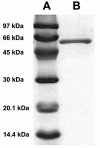Purification of the formate-tetrahydrofolate ligase from Methylobacterium extorquens AM1 and demonstration of its requirement for methylotrophic growth
- PMID: 14645277
- PMCID: PMC296244
- DOI: 10.1128/JB.185.24.7169-7175.2003
Purification of the formate-tetrahydrofolate ligase from Methylobacterium extorquens AM1 and demonstration of its requirement for methylotrophic growth
Abstract
The serine cycle methylotroph Methylobacterium extorquens AM1 contains two pterin-dependent pathways for C(1) transfers, the tetrahydrofolate (H(4)F) pathway and the tetrahydromethanopterin (H(4)MPT) pathway, and both are required for growth on C(1) compounds. With the exception of formate-tetrahydrofolate ligase (FtfL, alternatively termed formyl-H(4)F synthetase), all of the genes encoding the enzymes comprising these two pathways have been identified, and the corresponding gene products have been purified and characterized. We present here the purification and characterization of FtfL from M. extorquens AM1 and the confirmation that this enzyme is encoded by an ftfL homolog identified previously through transposon mutagenesis. Phenotypic analyses of the ftfL mutant strain demonstrated that FtfL activity is required for growth on C(1) compounds. Unlike mutants defective for the H(4)MPT pathway, the ftfL mutant strain does not exhibit phenotypes indicative of defective formaldehyde oxidation. Furthermore, the ftfL mutant strain remained competent for wild-type conversion of [(14)C]methanol to [(14)C]CO(2). Collectively, these data confirm our previous presumptions that the H(4)F pathway is not the key formaldehyde oxidation pathway in M. extorquens AM1. Rather, our data suggest an alternative model for the role of the H(4)F pathway in this organism in which it functions to convert formate to methylene H(4)F for assimilatory metabolism.
Figures



Similar articles
-
Formaldehyde-detoxifying role of the tetrahydromethanopterin-linked pathway in Methylobacterium extorquens AM1.J Bacteriol. 2003 Dec;185(24):7160-8. doi: 10.1128/JB.185.23.7160-7168.2003. J Bacteriol. 2003. PMID: 14645276 Free PMC article.
-
Functional investigation of methanol dehydrogenase-like protein XoxF in Methylobacterium extorquens AM1.Microbiology (Reading). 2010 Aug;156(Pt 8):2575-2586. doi: 10.1099/mic.0.038570-0. Epub 2010 May 6. Microbiology (Reading). 2010. PMID: 20447995
-
Biochemical properties and crystal structure of formate-tetrahydrofolate ligase from Methylobacterium extorquens CM4.Biochem Biophys Res Commun. 2020 Jul 30;528(3):426-431. doi: 10.1016/j.bbrc.2020.05.198. Epub 2020 Jun 4. Biochem Biophys Res Commun. 2020. PMID: 32505353
-
Methylobacterium extorquens: methylotrophy and biotechnological applications.Appl Microbiol Biotechnol. 2015 Jan;99(2):517-34. doi: 10.1007/s00253-014-6240-3. Epub 2014 Nov 30. Appl Microbiol Biotechnol. 2015. PMID: 25432674 Review.
-
Methylotrophy in Methylobacterium extorquens AM1 from a genomic point of view.J Bacteriol. 2003 May;185(10):2980-7. doi: 10.1128/JB.185.10.2980-2987.2003. J Bacteriol. 2003. PMID: 12730156 Free PMC article. Review. No abstract available.
Cited by
-
First insights into the syntrophic acetate-oxidizing bacteria--a genetic study.Microbiologyopen. 2013 Feb;2(1):35-53. doi: 10.1002/mbo3.50. Epub 2012 Dec 13. Microbiologyopen. 2013. PMID: 23239474 Free PMC article.
-
Recovering from a bad start: rapid adaptation and tradeoffs to growth below a threshold density.BMC Evol Biol. 2012 Jul 4;12:109. doi: 10.1186/1471-2148-12-109. BMC Evol Biol. 2012. PMID: 22762241 Free PMC article.
-
Genomic analysis of carbon source metabolism of Shewanella oneidensis MR-1: Predictions versus experiments.J Bacteriol. 2006 Jul;188(13):4601-9. doi: 10.1128/JB.01787-05. J Bacteriol. 2006. PMID: 16788168 Free PMC article.
-
Enzyme engineering and in vivo testing of a formate reduction pathway.Synth Biol (Oxf). 2021 Aug 6;6(1):ysab020. doi: 10.1093/synbio/ysab020. eCollection 2021. Synth Biol (Oxf). 2021. PMID: 34651085 Free PMC article.
-
Genome-resolved metagenomics identifies novel active microbes in biogeochemical cycling within methanol-enriched soil.Environ Microbiol Rep. 2024 Apr;16(2):e13246. doi: 10.1111/1758-2229.13246. Environ Microbiol Rep. 2024. PMID: 38575138 Free PMC article.
References
-
- Anantharam, V., M. J. Allison, and P. C. Maloney. 1989. Oxalate:formate exchange, the basis for energy coupling in Oxalobacter. J. Biol. Chem. 264:7244-7250. - PubMed
-
- Attwood, M. M., and W. Harder. 1972. A rapid and specific enrichment procedure for Hyphomicrobium spp. Antonie Leeuwenhoek 38:369-377. - PubMed
-
- Attwood, M. M., and J. R. Quayle. 1984. Formaldehyde as a central intermediary metabolite of methylotrophic metabolism, p. 315-323. In R. L. Crawford and R. S. Hanson (ed.), Microbial growth on C1 compounds. American Society for Microbiology, Washington, D.C.
Publication types
MeSH terms
Substances
Grants and funding
LinkOut - more resources
Full Text Sources
Molecular Biology Databases

